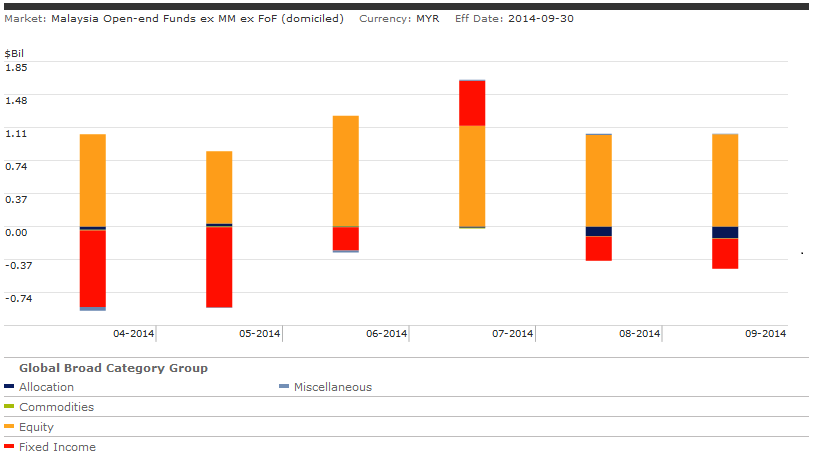Equity funds continue to see strong flows
1.035 billion (MYR) was put into equity funds in September. On the other hand, fixed income funds and allocation continue to recorded net outflows, estimated at 0.337 billion (MYR) and 0.129 billion (MYR).


Flows by Morningstar Categories
(Ranked by 1-Mo flow as of September 2014, excluding money markets and funds of funds)
Islamic Malaysia Equity funds again led all categories with 564 million (MYR) inflows. Public Islamic Opportunities fund and PB Islamic Equity fund were among those that saw significant inflows, estimated at 162 million (MYR) and 76 million (MYR) respectively.
CIMB-Principal Asia Pacific Dynamic Inc fund, categorized as Asia-Pacific ex-Japan Equity, recorded the largest inflow among all funds in September, estimated at 166 million (MYR).
MYR Bond saw the largest outflow in the month, estimated at 231 million (MYR). Hong Leong Income Management fund and CIMB-Principal Inst Bd fund 2 were among those suffered most, estimated at 141 million (MYR) and 96 million (MYR) respectively. Kenanga Income fund performed exceptionally well among the category, recorded 147 million (MYR) inflow.

Top- and Bottom- Flowing Mutual Funds in September
(Ranked by 1-Mo flow as of September 2014, excluding money markets and funds of funds)


Flows by Fund Family
(Ranked by assets as of September 2014, excluding money markets and funds of funds)
The largest fund family by AUM in Malaysia, Public Mutual, saw the strongest inflow in September, net inflows estimated at 329 million (MYR), though lower than the 444 million (MYR) recorded in August.

Important methodology note: Morningstar computes flows using the approach that is standard in the industry: Estimated net flow is the change in assets not explained by the performance of the fund. Our method assumes that flows occur uniformly over the course of the month. Adjustments for mergers are performed automatically. When liquidated funds are included, the final assets of the fund are counted as outflows. Reinvested dividends are not counted as inflows. We use fund-level reinvestment rates to improve accuracy in this respect. We make ad hoc adjustments for unusual corporate actions such as reverse share splits, and we overwrite our estimates with actual flows if managers are willing to provide the data to us. Please click here for a full explanation of our methodology.















